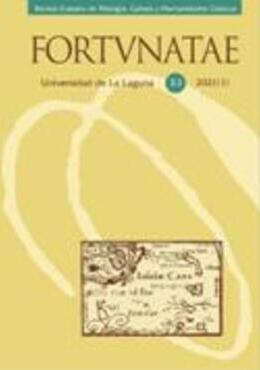How to approach Latin collocations in the classroom? A proposal based on their combinatory, semantic and syntactic features
Abstract
The aim of this article is twofold: on the one hand, to highlight the main combinatory, semantic and syntactic features of the collocations inLatin and, on the other hand, to provide a series of explanations and exercises that allow students to understand how they work. To do so, first we will focus on the restricted nature of this type of word combinations. Next, we will go deeper into the idea that the nouns, and not the verbs, are the semantic core of these constructions. And finally, we will analyze the syntactic contribution of each of these elements to the whole. All the theoretical explanation of our proposal will be accompanied by a series of practical activities focused on learning to identify, understand, and translate some collocations with the verbs facere, habere and dare.
References
ALONSO, Margarita (2004): Las construcciones con verbo de apoyo, Visor Libros, Madrid.
ALONSO, Zoa (2015): «La expresión latina motus dare. ¿Una colocación con verbo soporte?», en M. T. MUÑOZ - L. CARRASCO (eds.), Miscellanea latina, Sociedad de Estudios Latinos, Madrid, pp. 219-225.
BAÑOS, José Miguel (coord.) (2009): Sintaxis del latín clásico, Liceus, Madrid.
BAÑOS, José Miguel (2012): «Verbos soporte e incorporación sintáctica en latín: el ejemplo de ludos facere», Revista de Estudios Latinos (RELat) 12: 37-57.
BAÑOS, José Miguel (2016): «Las construcciones con verbo soporte en latín: sintaxis y semántica», en E. BORRELL - P. GÓMEZ (eds.), Omnia mutantur, Universitat de Barcelona, Barcelona, pp. 15-39.
BAÑOS, José Miguel y JIMÉNEZ, María Dolores (2017): «‘Arrepentirse’ en el Nuevo Testamento en griego y en latín: el empleo de las construcciones con verbo soporte en la Vulgata», Cuadernos de Filología Clásica. Estudios Latinos 37 (1): 11-32.
BASSOLS, Mariano ([1956] 1992): Sintaxis Latina,Consejo Superior deInvestigacionesCientíficas, Madrid.
BLÁNQUEZ, Agustín (1985): Diccionario Latín-Español, 3 vols., Sopena, Barcelona.
BODELOT, Colette y SPEVAK, Olga (2018) (dirs.): Les constructions à verbe support en latin, Cahiers du Laboratoire de Recherche sur le Langage, 7, Presses Universitaires Blaise Pascal, ClermontFerrand.
DE MIGUEL, Elena (2006): «Tensión y equilibrio semántico entre nombres y verbos: el reparto de la tarea de predicar», en M. VILLAYANDRE (ed.), Actas del XXXV Simposio Internacional de la Sociedad Española de Lingüística, Universidad de León, León, pp. 1289-1313.
EDEBÉ (2011): Latín I Bachillerato, Edebé, Barcelona.
GAFFIOT, Félix (1934): Dictionnaire Latin-Français, Hachette-Livre, Paris.
GARCÍA GUAL, Carlos; ANDRÉS, Mariano y MONGE, José Antonio (2010): Latín 1 Bachillerato, Santillana Educación, Madrid.
GARZÓN, Eveling y JIMÉNEZ, María Isabel (2018): «Quaestio: un análisis de la eventividad nominal a partir de sus colocaciones funcionales» en C. BODELOT - O. SPEVAK (dirs.), Les constructions à verbe support en latin, Cahiers du Laboratoire de Recherche sur le Langage, 7, Presses Universitaires Blaise Pascal, Clermont- Ferrand, pp. 53-75.
GLARE, P.G.W. (1968): Oxford Latin Dictionary, Clarendon Press, Oxford.
GROSS, Gaston (1994):«Classes d’objetset description des verbes», Langages 115:15-30,doi: https://doi.org/10.3406/lgge.1994.1684.
GROSS, Gaston (2008): «Les classes d’objets », Lalies 28: 111-165.
GROSS, Maurice (1981): «Les bases empiriques de la notion de prédicat sémantique», Langages 63: 7-52, doi: https://doi.org/10.3406/lgge.1981.1875.
HERRERO, José Luis (2002): «Los verbos soportes:el verbo daren español»,en M. GONZÁLEZ, M. SOUTO, A. VEIGA (coords.), Léxico y gramática, Tris Tram, Lugo, pp. 189-202.
HIGUERAS, Marta (1996): «Aprender y enseñar léxico», en L. MIGUEL - N. SANS (coords.), Didáctica del español como lengua extranjera, 3, Colección Expolingua, Fundación Actilibre, Madrid, pp. 111-126.
HOFMANN, Johann Baptist (1958): El latín familiar (traducido y anotado por J. Corominas), Instituto Antonio de Nebrija, Madrid.
ÍRSULA, Jesús (1994): «¿Entre el verbo y el sustantivo, quién rige a quién? El verbo en las colocaciones sustantivo-verbales» en A. ENDRUSCHAT, M. VILELA, G. WOTJAK (eds.), Verbo e estruturas frásicas / Colóquio Internacional de Linguística Hispânica, Faculdade de Letras do Porto, Porto, pp. 277-286.
JIMÉNEZ, María Isabel (2016): Colocaciones y verbos soporte: semántica y sintaxis del verbo pono [Tesis Doctoral], Universidad Complutense de Madrid, Madrid.
JIMÉNEZ, María Isabel y MELIS, Chantal (2018): «Evolución de las colocaciones causativas emocionales del latín al español», Anuario de Letras. Lingüística y Filología 6 (2): 75-109.
KOIKE, Kazumi (2001): Colocaciones léxicas en el español actual: estudio formal y léxico-semántico, Universidad de Alcalá de Henares, Madrid.
LANGER, Stefan (2005): «A formal specification of Support Verb Constructions», en S. LANGER - D. SCHNORBUSCH, Semantik im Lexikon, Narr, Tübingen, pp. 179-202.
LEWIS, Michael (2000): Teaching Collocation: Further Development in the Lexical Approach, Language Teaching Publications, Hove.
LÓPEZ, Iván (2019): «Las colocaciones verbo-nominales en griego y en latín: una comparación entre César y Jenofonte», Cuadernos de Filología Clásica. Estudios Latinos 39 (2): 209-225.
MARTÍN, Antonio María (1996): «Dare, auxiliaire lexical en latin», en FRUYT, M. - MOUSSY, C. (eds.), Structures lexicales du latin: actes de la table ronde du VII e Colloque, Presses de l’Université de Paris-Sorbonne, Paris, pp. 149-168.
MARTÍN, Antonio María (2018): «Les emplois de dare comme verbe support: une réévaluation», en C. BODELOT - O. SPEVAK (dirs.), Les constructions à verbe support en latin, Cahiers du Laboratoire de Recherche sur le Langage, 7, Presses Universitaires Blaise Pascal, Clermont-Ferrand, pp. 149-167.
MEL’CUK, Igor (1995): «Phrasemes in Language and Phraseology in Linguistics», en M. EVERAERT - E. J. Van der LIENDEN (eds.), Idioms: Structural and Psychological Perspectives, Lawrence Erlbaum Associates, Hillsadle - Hove, pp. 167-232.
MENDÓZAR, Juan (2015): «Causatividad y construcciones con verbo soporte en latín: el ejemplo de poena afficere», Cuadernos de Filología Clásica. Estudios Latinos 35 (1): 7-28.
MENDÓZAR, Juan (2020): «Las construcciones con verbo soporte en latín. Estado de la cuestión», Tempus 47: 7-48.
PENADÉS, Inmaculada (2017): «Arbitrariedad y motivación en las colocaciones», Revista de Lingüística Teórica y Aplicada 55 (2): 121-142.
PINKSTER, Harm (2015): The Oxford Latin Syntax.Volume 1:The Simple Clause, Oxford University Press, Oxford.
POMPEI, Anna (2016): «Construction Grammar and Latin: the case of habeo», Pallas 102: 99-108, doi: https://doi.org/10.4000/pallas.3601.
POMPEI, Anna (2018): «Facere saltum ou dare saltum? Verbes supports et noms de mouvement», en C. BODELOT - O. SPEVAK (dirs.), Les constructions à verbe support en latin, Cahiers du Laboratoire de Recherche sur le langage, 7, Presses Universitaires Blaise Pascal, Clermont-Ferrand, pp. 169-186.
RUBIO, Lisardo (1982): Introducción a la sintaxis estructural del latín, Ariel, Madrid-Caracas-México.
SANCHIS, Josefa (2012): Latín 1 Bachillerato, McGraw-Hill, Madrid.
TUR, Cristina (2019): Sintaxis y semántica de los nombres de sentimiento en latín: empleos adverbales y colocaciones [Tesis Doctoral], Universidad Complutense de Madrid, Madrid.
TUR, Cristina (2020): «Una aproximación a la enseñanza de las colocaciones latinas a través de metáforas cognitivas», EClás. 158: 123-140.
VARRÓN (1990):De Lingua Latina. Introducción, traducción y notas de Manuel Antonio Marcos Casquero, Ministerio de Educación y Ciencia y Anthropos, Madrid-Barcelona.
VOX (2002): Diccionario Ilustrado Latín. Latino-Español, Español-Latino, 21ªed., Spes Editorial, Barcelona.
Authors retain copyright and grant the journal the right to be the first publication of the work as well as license it under a Creative Commons Attribution License that allows others to share the work with acknowledgment of authorship of the work and initial publication in this magazine.
Authors may separately establish additional agreements for the non-exclusive distribution of the version of the work published in the journal (for example, placing it in an institutional repository or publishing it in a book), with an acknowledgment of its initial publication in this journal.





